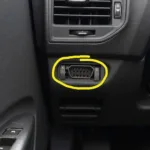Knowing whether your car uses OBD1 or OBD2 is essential for diagnosing and fixing any issues. But with so many car models and manufacturing years, it can be a little confusing. This guide will walk you through everything you need to know to determine which system your car uses.
Understanding OBD Systems: OBD1 vs. OBD2
Before we dive in, let’s quickly understand what OBD systems are. OBD stands for On-Board Diagnostics, a standardized system that allows you to communicate with your car’s computer and access diagnostic information.
OBD1: The Early Days of Car Diagnostics
Introduced in the late 1980s, OBD1 was the first generation of onboard diagnostics. It was primarily focused on monitoring emissions-related components and systems. OBD1 systems were manufacturer-specific, meaning the connector type, location, and diagnostic procedures varied significantly between car makes and models.
OBD2: The Standardized Approach
In 1996, a more advanced and standardized system, OBD2, was introduced. It provided a universal connector and protocol for accessing diagnostic information, making it easier for mechanics and car owners to diagnose and repair vehicles regardless of the make or model.
So, How do I Know if My Car has OBD1 or OBD2?
Here are a few ways to determine whether your car is equipped with OBD1 or OBD2:
1. Check the Vehicle’s Model Year
The most straightforward way to determine your car’s OBD system is by its model year:
- 1996 and Newer Vehicles: In the United States, all cars and light trucks manufactured in 1996 and later are required to be OBD2 compliant.
- Pre-1996 Vehicles: Cars manufactured before 1996 were equipped with OBD1 or earlier systems. However, some manufacturers started incorporating OBD2 in certain models as early as 1994.
Note: While the 1996 cut-off generally applies to the US market, other regions might have adopted OBD2 at different timelines. It’s always a good idea to double-check for your specific region.
2. Inspect the Diagnostic Connector
Another reliable method is to physically examine the diagnostic connector in your car:
- OBD2 Connector: The OBD2 connector is a 16-pin, trapezoidal-shaped port, typically located under the dashboard on the driver’s side.
- OBD1 Connector: OBD1 connectors, on the other hand, come in various shapes and sizes and are often found under the hood near the engine or in other less accessible locations.
3. Consult the Vehicle’s Owner’s Manual
Your car’s owner’s manual should provide information about the onboard diagnostic system used in your vehicle. Look for sections related to “emissions,” “diagnostics,” or “OBD.”
4. Use an Online OBD Lookup Tool
Several websites and online resources allow you to enter your car’s make, model, and year to determine the type of OBD system it uses.
What if My Car is OBD1?
If you discover your car utilizes the older OBD1 system, don’t worry. While finding information and compatible diagnostic tools might require a bit more effort compared to OBD2, resources are available. You can consult manufacturer-specific forums, online databases, or specialized mechanics familiar with older vehicle systems.
“Working with OBD1 systems can be like going back to the basics,” says veteran mechanic John Miller. “It often requires a deeper understanding of the specific vehicle’s wiring diagrams and sensor specifications, but it can be incredibly rewarding to diagnose and solve issues on these older cars.”
OBD2: Your Gateway to Vehicle Insights
If your car utilizes OBD2, you have access to a wealth of diagnostic information and a wide range of compatible scanners and tools. With an OBD2 scanner, you can:
- Read and clear diagnostic trouble codes (DTCs): These codes provide insights into potential issues with your car’s engine, transmission, emissions system, and more.
- Monitor live data streams: Observe real-time sensor readings like engine RPM, coolant temperature, oxygen sensor voltage, and more, providing valuable insights into your car’s performance.
- Perform advanced diagnostics: Depending on the scanner’s capabilities, you might be able to access manufacturer-specific codes, perform actuator tests, and access other advanced diagnostic functions.
Conclusion
Knowing whether your car uses OBD1 or OBD2 is crucial for effective diagnostics and repairs. By following the steps outlined in this guide, you can quickly and easily determine which system your car has. Remember, if you encounter any difficulties, don’t hesitate to seek assistance from a qualified mechanic or automotive specialist.
